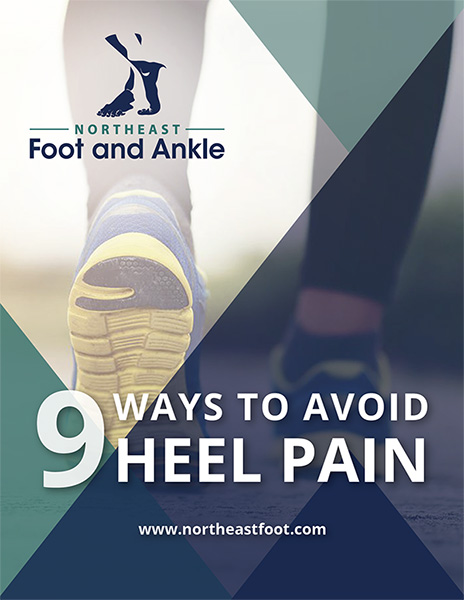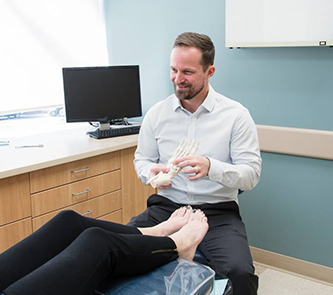Achilles Tendinitis
Heel pain is an incredibly common problem. A major contributing factor for this is the fact it’s caused by several different root causes. Some of the conditions that cause heel pain include:
- Plantar fasciitis
- Achilles tendinitis
- Sever’s disease
- Bursitis
- Heel Spurs
- Calcaneal fractures
From that list, plantar fasciitis is the leading source of adult heel pain. Perhaps the second-most common is Achilles tendinitis.
Understanding this common foot injury is instrumental in knowing when to seek treatment, how to prevent further damage to the injured tendon, and even reducing your risk of having it develop in the first place.
When you do need professional care for a severe case of Achilles tendinitis—or any foot or ankle injury, actually—our team of foot and ankle experts located in Portsmouth and Nashua are the most trusted source!
The Achilles Tendon—Not Just a Legend!
The Achilles Heel is not just an ancient legend or a metaphor for vulnerability. Achilles tendonitis is literally a pain in the heel.
The best starting point in discussing this injury is with the affected tissue:
Regarding connective tissues in your body, the two you’re most likely to be familiar with are tendons and ligaments. This often raises the question—what’s the difference between a tendon and ligament?
Whereas both tissues are anchored to bones on one end, the distinction is what’s connected on the other side. If it’s another bone, then we’re talking about ligaments. If the tissue connects a bone to a muscle, however, it’s a tendon.
Your body has approximately 640 muscles, along with thousands of tendons connecting them to various bones in your skeletal system. Your body moves when muscles either contract or expand, thereby pulling or pushing (respectively) tendons connected to bones.
(As we discuss the Achilles tendon specifically in just a moment, you’ll see a great example of how this works.)
Out of all those tendons in your musculoskeletal system, your Achilles tendons are the strongest and largest. In fact, these particular tendons are uniquely structured. Whereas other tendons have fibers that line up side-by-side—like bristles on a broom—these ones are wrapped around like a heavy-duty cable.
Of course, an Achilles needs to be quite strong on account of the role it has in allowing a foot to move either up or down!
See, the Achilles tendon is anchored on one end to the bottom of your calf muscle, and the calcaneus (heel bone) on the other. When your calf muscle contracts, it pulls on the heel bone and your foot points downward. As you might expect, elongating the calf muscle push the heel bone and raises your foot.
Now think about how your foot moves as you take a step. When it lands, your toes are raised, right? But then the rest of your foot comes down during the ground portion of the step, culminating in a final push from the toes as you contract your calf muscle.
In the back of your heel and lower leg, the Achilles tendon is activated pretty much the entire time.
An Irritated Achilles Tendon
When subjected to overuse from repetitive strain, or excessive force loads from intense physical activity, the strong-but-not-infallible tendon can become injured. When it does, inflammation occurs—which is understandable if you know that that the “-itis” suffix is used for medical conditions featuring inflamed (swollen) tissues.
The key symptoms you will typically experience from this injury includes pain, tenderness, and tendon stiffness.
Earlier, we noted that Achilles tendinitis and plantar fasciitis are the two most common sources of heel pain, so how can you tell which one you’ve sustained?
When and where the pain presents can often steer you in the right direction:
- For plantar fasciitis, pain is strongest following periods of rest and most prominent in the bottom of the heel.
- For Achilles tendinitis, pain is strongest during and immediately following physical activity and most prominent in the back of the heel or calf.
Further, there are two distinct types of Achilles tendinitis that will present symptoms a bit differently from each other:
- Non-insertional Achilles tendinitis (the pain in the tendon kind) usually affects younger, more active patients. They will feel sore or stiff in the morning get worse throughout the day. Swelling or a bump may even be felt along the middle of the tendon, caused by the fibers degenerating and thickening due to overuse.
- Insertional Achilles tendinitis (the pain at the back of the heel bone kind)can affect just about anyone. Morning stiffness and increasing soreness are also experienced throughout the day. Patients are more likely to have tight calf muscles and may develop a bone spur where the Achilles tendon inserts into the bone.
Middle-aged adults—and especially men—have the highest risk factor for this condition. In part, this is attributable to the fact the Achilles starts weakening as we age and, thus, are more susceptible to injury. On top of that, this particular demographic has many “weekend warriors.”
Weekend warriors are those who might be too busy (or have no interest) to exercise on a regular basis during the week but will then give it the proverbial “110%” playing in recreational sports leagues or competing with friends on the tennis or basketball courts (etc.).
Beyond age and sporadic bursts of intense sports competition, there are other possible causes and risk factors, including:
- Starting a new running program at too high an intensity level with regards to speed, duration, or distance.
- Suddenly ramping up the volume or intensity of an existing fitness regimen.
- Wearing high-heeled footwear for prolonged periods (since these kinds of shoes keep calf muscles contracted).

Treating Achilles Tendinitis
We do have some good news to share about this common injury—self-care measures can be rather effective for cases that are mild or tended to early.
In fact, once you become aware of those aforementioned symptoms, you should start caring for your injured Achilles by using RICE (rest, ice, compression, and elevation). Doing so gives your body time to initiate natural healing processes, while at the same time relieving inflammation and reducing pain.
Additionally, you may want to consider taking an over-the-counter nonsteroidal anti-inflammatory drug (NSAID), such as ibuprofen or naproxen sodium. Of course, you should consult with our office first for appropriate dosage recommendations.
Whereas self-care may be beneficial for some cases, you might prefer to come see us for a professional treatment plan. This is especially applicable when this injury is severe or persistent in nature, or you haven’t been able to achieve optimal results on your own.
When you do request an appointment with either our Portsmouth or Nashua offices, we will provide a careful diagnosis and then create a customized treatment plan for you.
So as to alleviate any potential concerns, we’d like to note that this injury rarely requires surgical intervention. Our conservative treatments are typically quite effective in resolving the problem.
Even better, of course, is to take the appropriate measures to prevent this problem from happening in the first place.
To that end, it’s essential that you start new exercise programs at relatively easy levels of duration and intensity, and then gradually build them up over time.
Other prevention tips include:
- Stretch your lower limbs on a regular basis (and especially your calf muscles!).
- Wear shoes featuring solid arch support and appropriate amounts of cushioning.
- Instead of relying solely on running or high-impact activities for your fitness, use a cross-training program that incorporates low-impact exercises (biking, swimming, yoga, etc.).
The Legend
The legend of Achilles (Greek Mythology) says that he was predicted to die at a young age. To save him, he was dipped into a magic river by his mother (Thetis) in order to make him invulnerable. His heel wasn’t covered by the magic water because she had grasped him by the heel in order to dip him. His heel remained mortal and he was later killed by an arrow wound to his heel. Although the legend is ancient, the phrase “Achilles Heel” wasn’t picked up in English until the 19th century. It is now commonly used as a metaphor.
Achilles himself is just a myth but Achilles pain is a common occurrence at Northeast Foot and Ankle!
Comprehensive Foot & Ankle Sports Injury Treatment
Whether you are coming from Dover, Durham, Newmarket, or anywhere in between, for more information on this subject, or to request an appointment with either of our offices, call (603) 431-6070. One of our team members located in Nashua and Portsmouth will be glad to answer any questions you may have or provide additional assistance.
Pay Your Bill
Make a payment online through our payment portal or Care Credit!
Portsmouth Office
14 Manchester Square, Suite 250
Portsmouth, NH 03801
Nashua Office
17 Riverside Street, Suite 205
Nashua, NH 03062
Website Hosted by SC Digital




